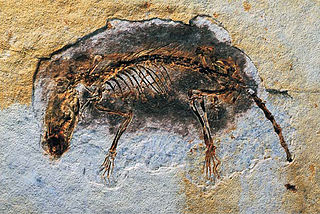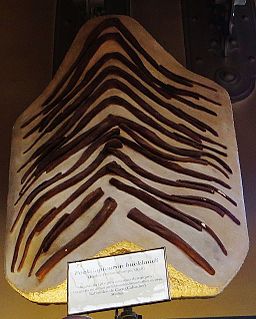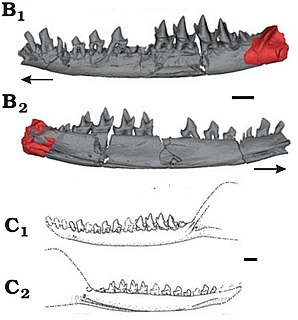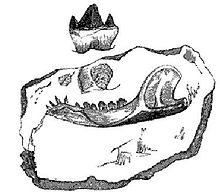
Multituberculata is an extinct order of rodent-like mammals with a fossil record spanning over 130 million years. They first appeared in the Middle Jurassic, and reached a peak diversity during the Late Cretaceous and Paleocene. They eventually declined from the mid Paleocene onwards, disappearing from the known fossil record in the late Eocene. They are the most diverse order of Mesozoic mammals with more than 200 species known, ranging from mouse-sized to beaver-sized. These species occupied a diversity of ecological niches, ranging from burrow-dwelling to squirrel-like arborealism to jerboa-like hoppers. Multituberculates are usually placed as crown mammals outside either of the two main groups of living mammals—Theria, including placentals and marsupials, and Monotremata—but usually as closer to Theria than to monotremes. They are considered to be closely related to Euharamiyida and Gondwanatheria as part of Allotheria.

Eomaia is a genus of extinct fossil mammals containing the single species Eomaia scansoria, discovered in rocks that were found in the Yixian Formation, Liaoning Province, China, and dated to the Barremian Age of the Lower Cretaceous about 125 million years ago. The single fossil specimen of this species is 10 centimetres (3.9 in) in length and virtually complete. An estimate of the body weight is between 20–25 grams (0.71–0.88 oz). It is exceptionally well-preserved for a 125-million-year-old specimen. Although the fossil's skull is squashed flat, its teeth, tiny foot bones, cartilages and even its fur are visible.

Catopsbaatar is a genus of multituberculate, an extinct order of rodent-like mammals. It lived in what is now Mongolia during the late Campanian age of the Late Cretaceous epoch, about 72 million years ago. The first fossils were collected in the early 1970s, and the animal was named as a new species of the genus Djadochtatherium in 1974, D. catopsaloides. The specific name refers to the animal's similarity to the genus Catopsalis. The species was moved to the genus Catopsalis in 1979, and received its own genus in 1994. Five skulls, one molar, and one skeleton with a skull are known; the last is the genus' most complete specimen. Catopsbaatar was a member of the family Djadochtatheriidae.

Megalosaurus is an extinct genus of large carnivorous theropod dinosaurs of the Middle Jurassic period of Southern England. Although fossils from other areas have been assigned to the genus, the only certain remains of Megalosaurus come from Oxfordshire and date to the late Middle Jurassic.

Scelidosaurus is a genus of herbivorous armoured ornithischian dinosaur from the Jurassic of the British Isles.

Dimorphodon was a genus of medium-sized pterosaur from the early Jurassic Period. It was named by paleontologist Richard Owen in 1859. Dimorphodon means "two-form tooth", derived from the Greek δι meaning "two", μορφη meaning "shape" and οδων meaning "tooth", referring to the fact that it had two distinct types of teeth in its jaws – which is comparatively rare among reptiles. Dimorphodon inhabited Europe.

Poekilopleuron is a genus of tetanuran dinosaur, which lived during the middle Bathonian of the Jurassic, about 168 to 166 million years ago. The genus has been used under many different spelling variants, although only one, Poekilopleuron, is valid. The type species is P. bucklandii, named after William Buckland, and many junior synonyms of it have also been erected. Few material is currently known, as the holotype was destroyed in World War II, although many casts of the material still exist.

Palorchestes is an extinct genus of terrestrial, herbivorous marsupials of the family Palorchestidae. The genus was endemic to Australia, living from the Miocene through to the Pleistocene epochs.

Rhamphocephalus is an extinct genus of fossil reptile from the Middle Jurassic Great Oolite Group of Gloucestershire, England. The name was erected as a genus of pterosaur and became a 'wastebasket taxon' for British Jurassic pterosaur remains until a recent revision. Rhamphocephalus comprises several named species, two of which are pterosaurian, but the type species - R. prestwichi - is based on remains now identified as a thalattosuchian. Because it is poorly preserved and lacks features that distinguish it from other thalattosuchians, R. prestwichi is considered an invalid species and the genus Rhamphocephalus is a nomen dubium. Reassessments of other Rhamphocephalus species suggest they are also undiagnostic to species level, although they have properties allowing referral to some Jurassic pterosaur groups.

Kuehneotherium is an early mammaliaform genus, previously considered a holothere, that lived during the Late Triassic-Early Jurassic Epochs and is characterized by reversed-triangle pattern of molar cusps. Although many fossils have been found, the fossils are limited to teeth, dental fragments, and mandible fragments. The genus includes Kuehneotherium praecursoris and all related species. It was first named and described by Doris M. Kermack, K. A. Kermack, and Frances Mussett in November 1967. The family Kuehneotheriidae and the genus Kuehneotherium were created to house the single species Kuehneotherium praecursoris. Modeling based upon a comparison of the Kuehneotherium jaw with other mammaliaforms indicates it was about the size of a modern-day shrew between 4 and 5.5 g at adulthood.
The Taynton Limestone is a geological formation in Oxfordshire in the United Kingdom. It dates to the Middle Jurassic, mid-Bathonian stage. It predominantly consists of ooidal grainstone. The term "Stonesfield Slate" refers to slaty limestone horizons within the formation that during the 18th and 19th centuries were extensively quarried for use in roof tiling within the vicinity of Stonesfield, Oxfordshire. Previously these were thought to belong to the Sharp's Hill Formation, but boreholes and shaft sections suggest that at least three horizons within the Taynton Limestone were quarried for the slate. These horizons are well known for producing a diverse set of fossils including those of plants, insects as well as vertebrates, including some of the earliest known mammals, pterosaurs as well as those of first dinosaur ever described, Megalosaurus.

Monotremes are prototherian mammals of the order Monotremata. They are one of the three groups of living mammals, along with placentals (Eutheria) and marsupials (Metatheria). Monotremes are typified by structural differences in their brains, jaws, digestive tract, reproductive tract, and other body parts, compared to the more common mammalian types. In addition, they lay eggs rather than bearing live young, but, like all mammals, the female monotremes nurse their young with milk.
Amphilestes is a genus of extinct eutriconodont mammal from the Middle Jurassic of the United Kingdom. It was one of the first Mesozoic mammals discovered and described.
Several mammals are known from the Mesozoic of Madagascar. The Bathonian Ambondro, known from a piece of jaw with three teeth, is the earliest known mammal with molars showing the modern, tribosphenic pattern that is characteristic of marsupial and placental mammals. Interpretations of its affinities have differed; one proposal places it in a group known as Australosphenida with other Mesozoic tribosphenic mammals from the southern continents (Gondwana) as well as the monotremes, while others favor closer affinities with northern (Laurasian) tribosphenic mammals or specifically with placentals. At least five species are known from the Maastrichtian, including a yet undescribed species known from a nearly complete skeleton that may represent a completely new group of mammals. The gondwanathere Lavanify, known from two teeth, is most closely related to other gondwanatheres found in India and Argentina. Two other teeth may represent another gondwanathere or a different kind of mammal. One molar fragment is one of the few known remains of a multituberculate mammal from Gondwana and another has been interpreted as either a marsupial or a placental.

Amphitherium is an extinct genus of stem cladotherian mammal that lived during the Middle Jurassic of England. It was one of the first Mesozoic mammals ever described. A recent phylogenetic study found it to be the sister taxon of Palaeoxonodon. It is found in the Forest Marble Formation and the Taynton Limestone Formation.

Triconodon is a genus of extinct mammal from the Early Cretaceous of England and France with two known species: T. mordax and T. averianovi. First described in 1859 by Richard Owen, it is the type genus for the order Triconodonta, a group of mammals characterised by their three-cusped (triconodont) molar teeth. Since then, this "simplistic" type of dentition has been understood to be either ancestral for mammals or else to have evolved multiple times, rendering "triconodonts" a paraphyletic or polyphyletic assemblage respectively, but several lineages of "triconodont" mammals do form a natural, monophyletic group, known as Eutriconodonta, of which Triconodon is indeed part of.
Wareolestes rex is a mammaliaform from the Middle Jurassic (Bathonian) rocks of England and Scotland. It was originally known from isolated teeth from England, before a more complete jaw with teeth was found in the Kilmaluag Formation of Skye, Scotland.

Palaeoxonodon is an extinct genus of Cladotherian mammal from the Middle Jurassic of England and Scotland.

Peradectes is an extinct genus of small metatherian mammals known from the Cretaceous and Paleocene of North and South America through the Eocene of North America and parts of Europe. The first discovered fossil of P. elegans, was one of 15 Peradectes specimens described in 1921 from the Mason pocket fossil beds in Colorado.



















